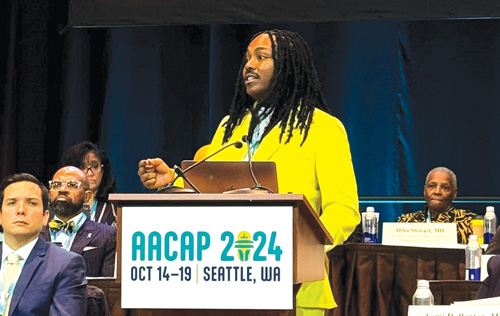A former foster-child-turned-advocate told his story of survival, explained why policy changes in the foster care system are needed, and urged clinicians to be part of that change, according to a plenary session at the recent annual meeting of the American Academy of Child and Adolescent Psychiatry.
After he and his siblings were removed from their mother’s care by the state of Michigan due to severe neglect and abandonment, Karlos Dillard, advocate and author of “Ward of the State: A Memoir of Foster Care," said he endured more than 30 foster care placements. “Few good, many abusive,” he said. “If we are expecting mental health providers to help these children, we need you to understand the challenges we encounter.”
“I was so overmedicated that it was really hard to tell which emotions I was even feeling,” said Dillard, who told attendees he attempted suicide when he was just 8 years old. He was taking a cocktail of risperidone, dextroamphetamine, amphetamine, methylphenidate, and bupropion, and his mind was so foggy, he felt like a zombie.
According to a study issued in 2023, children in foster care are seven times more likely to be prescribed psychotropic medication than non-foster children on Medicaid, even after accounting for their age, gender, and number of mental and developmental diagnoses. Overall, 35% of foster youth were dispensed at least one prescription for psychotropic medication, compared to 8% of non-foster youth on Medicaid, according to the study by Rachel J. Keefe, M.D., M.P.H., at Baylor College of Medicine in Houston and colleagues, issued in the Journal of Child and Adolescent Psychopharmacology.
Another concern that warrants greater attention is how the $1.3 billion in federal government funding is doled out to foster parents, said Dillard, quoting figures from the Child Welfare League of America. The current system pays a premium to parents who take in youth with certain diagnoses or who are in need a higher level of care. “Often times foster parents will overexaggerate or lie about our behaviors to our doctors, with the promise that they will receive a higher monthly stipend from their agencies.” That can lead to overmedication, he said.
Dillard also called into question the system that allows foster parents to “stack” three or four high-needs children into one home to boost their monthly payments. This practice does not serve the youth living in such a home, he suggested. One set of foster parents beat him so badly that he was left covered in bruises all over his face and body, he recounted.
To hide their crime, the foster parents dialed 9-1-1 and lied to emergency services that Dillard was self-harming and suicidal. No one believed his side of the story, and after 72 hours, he was sent right back to that same family. Not only did the abuse continue, but the foster parents received higher payments from the state after Dillard’s hospitalization, he said.
What Clinicians Can Do
Dilliard said clinicians should do more to create a safe space where foster youth can express their true feelings. Key to this is sending foster parents out of the room during sessions with youth, he said. Foster parents’ presence can serve to “intimidate the youth from telling the truth to their doctor.”
Dilliard also called for better communication among clinicians about youth in the foster care system, perhaps via a centralized, electronic recordkeeping system. “I moved from home to home to home across the state of Michigan,” he said. Each new clinician he saw had to start from scratch, leaving them overly reliant on the word foster parents and leaving his care more prone to mismanagement and medication errors.
Dillard said clinicians should also make room for people with lived experience to work with foster youth. “We are the experts in the field,” he said. He cautioned that there is no place in the foster care system for non-evidence-based therapies, such as the “rebirthing” or “birthwork” therapy, for which he endured being wrapped up and subjected to torturous physical pressure and screaming in his face. “That played a role in my distrust of mental health clinicians. It took me more than 20 years to trust mental health providers again.”
Dilliard did urge clinicians to fully explore evidence-based psychotherapies before turning to medication, particularly when dealing with trauma-related behaviors. When medication is required, he urged careful monitoring of dosages and side effects. “Overmedication can dull a child’s emotional range, contributing to more trauma,” he said.
Change is needed to help reverse the tide: Research shows that between 31% and 46% of youth who exit foster care experience homelessness by the time they turn 26 years old, Dillard said. They are also more likely to experience justice system involvement: one study found that by age 17, over half of youth in foster care experienced an arrest, conviction, or an overnight stay in a correctional facility.
“It is important to remember that change is positive,” Dillard said. “We don’t have to accept this as the future of care. Each and every single one of you has the power to be part of that change.” ■

